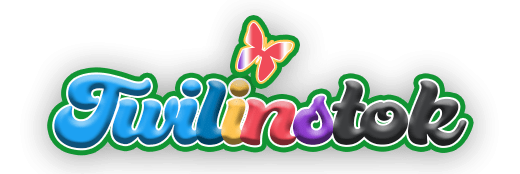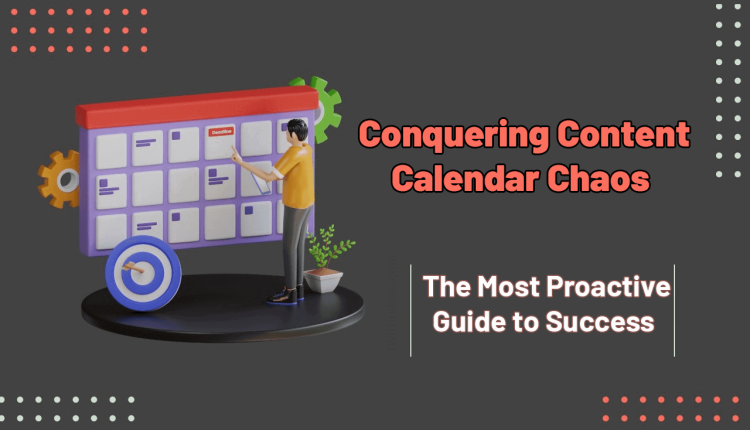Conquering Content Calendar Chaos: The Most Proactive Guide to Success
Conquering Content Calendar Chaos
Have you ever stared at a blank document, a deadline looming, feeling utterly lost in a sea of content ideas? You’re not alone. In today’s fast-paced digital world, consistent content creation is crucial for online success. But without the right tools and strategies, it can quickly spiral into a chaotic mess of missed deadlines, inconsistent quality, and a whole lot of stress.
The good news? A hero is waiting in the wings: the content calendar. This powerful tool can be your secret weapon for conquering content calendar chaos and achieving content marketing mastery. The purpose of this article from Twilinstok is to guide you through the use of specialized and efficient tools for Conquering Content Calendar Chaos.
Understanding the Roots of Content Calendar Chaos
Before we dive into building the perfect content calendar, let’s explore the common culprits behind content chaos:
- Lack of planning and organization: Winging it rarely works. Without a clear plan, you’ll struggle to generate ideas, prioritize tasks, and meet deadlines.
- Unclear goals and target audience: Not knowing your target audience is like shooting arrows in the dark. Content that resonates with your ideal audience is key to success.
- Unrealistic deadlines and workloads: Unrealistic deadlines and overloaded workloads are a recipe for burnout and missed deadlines.
- Poor content creation workflow: A disorganized content creation process leads to confusion and delays. Streamlining your workflow can make a world of difference.
- Inadequate tracking and analytics: If you’re not measuring your content’s performance, you’re flying blind. Data insights are essential for optimizing your content strategy.
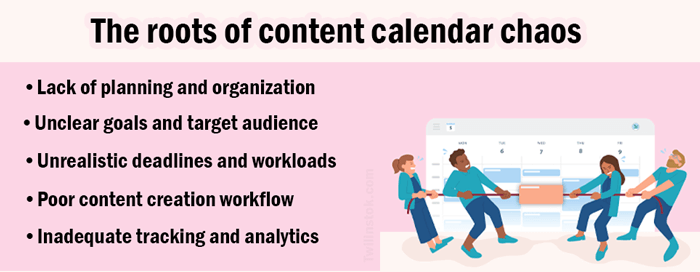
Building a Proactive Content Calendar: Your Roadmap to Success
Now that we’ve identified the enemy, let’s build a content calendar that empowers you to create high-quality content consistently.
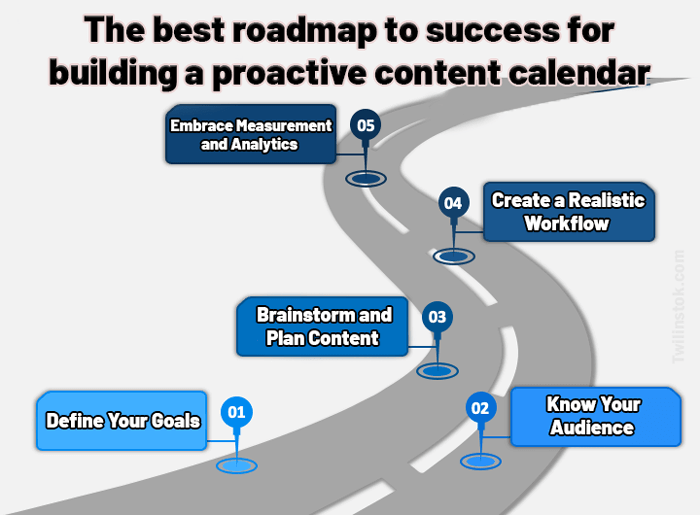
1. Define Your Goals:
What do you want to achieve with your content marketing efforts? Do you want to increase brand awareness, generate leads, or drive website traffic? Having clear goals allows you to create content that aligns with your overall marketing strategy.
For example, if your goal is to generate leads, you might focus on creating informative blog posts, downloadable white papers, or gated E-books that offer valuable insights to potential customers.
2. Know Your Audience:
Before creating content, you need to understand who you’re creating it for. Conduct audience research through surveys, social media analytics, or competitor analysis. This will help you tailor your content to their needs, interests, and pain points.
3. Brainstorm and Plan Content:
Get those creative juices flowing! Brainstorm a variety of content ideas that resonate with your audience and support your marketing goals.
Consider utilizing content mapping, a technique that matches specific content themes to different audience segments and your marketing objectives.
There are also numerous online content calendar templates and project management software tools available to help you visualize and organize your content plan.
What is a Content Calendar Template?
A content calendar template is a pre-designed framework that helps you organize your content plan visually. It typically includes sections for:
- Content Topic: Briefly describe the subject of your content piece.
- Content Type: Specify the format (e.g., blog post, infographic, video).
- Target Audience: Identify the specific audience segment you’re targeting.
- Publishing Date: Set a target date for publishing the content.
- Keywords: Include relevant keywords you want to target for SEO purposes.
- Author/Assignee: Assign responsibility for content creation to a specific team member.
- Status: Track the progress of your content (e.g., brainstorming, in progress, complete).
Using a content calendar template offers several benefits:
- Improved Organization: Visualize your entire content plan at a glance and ensure a consistent flow of content.
- Streamlined Collaboration: Facilitate teamwork by clearly outlining content creation tasks and responsibilities.
- Enhanced Efficiency: Save time by having a pre-formatted structure for your content plan.
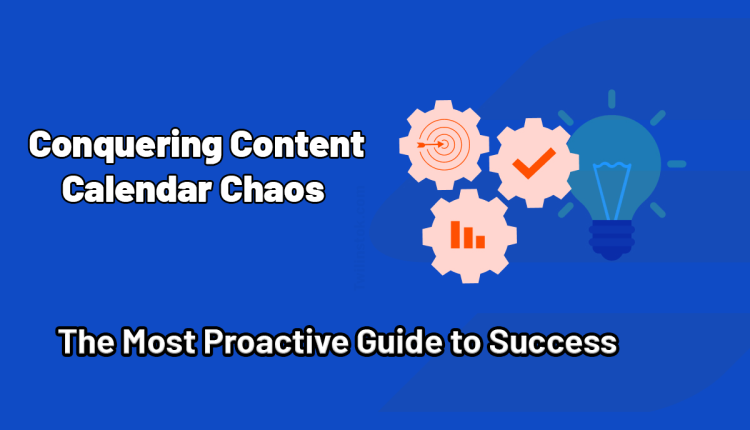
The Best Content Calendar Tools
There are various tools available to create and manage your content calendar, each with its advantages:
- Spreadsheets (Free): A readily available and familiar option for creating basic content calendars. Tools like Google Sheets offer free templates and collaboration features.
- Project Management Software (Paid/Freemium): Popular options like Asana, Trello, and Monday.com offer advanced features like task management, workflow automation, and integrations with other marketing tools. Some provide free plans with limited features.
- Content Marketing Platforms (Paid): Platforms like HubSpot, CoSchedule, and Sprout Social offer comprehensive content calendar features alongside additional marketing tools like social media scheduling and analytics. These are typically paid solutions.
How to Choose the Right Content Calendar Tools
The ideal tool depends on your specific needs and budget. Here’s a quick guide:
- For basic needs: Start with a free spreadsheet template.
- For growing teams and collaboration: Consider project management software.
- For comprehensive content marketing solutions: Explore content marketing platforms (if the budget allows).
4. Create a Realistic Workflow:
Break down content creation into manageable tasks like research, writing, editing, and creating visuals. Assign deadlines and responsibilities to ensure accountability. You can also explore content creation workflows like batching (creating content in bulk) or agile (flexible and adaptable to changes).
5. Embrace Measurement and Analytics:
Don’t just create content and hope for the best. Track your content’s performance using relevant metrics like engagement, reach, and conversions. Popular analytics tools can provide valuable insights to optimize your content strategy and identify what resonates best with your audience.
Harnessing the Power of Content Analytics
Creating content is just half the battle. To truly optimize your content strategy, you need to understand how your content performs with your target audience. This is where content analytics tools come in. These tools track key metrics that provide valuable insights into your content’s effectiveness.
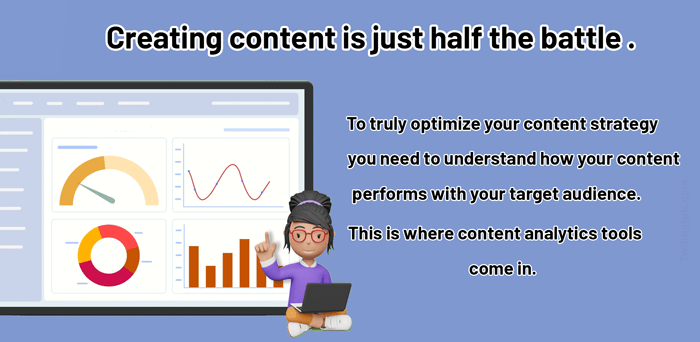
The Most Popular Content Analytics Tools
Here are some popular content analytics tools and how they can benefit your content strategy:

Google Analytics
Google Analytics is a free and powerful tool from Google that provides a wealth of data on your website traffic, including:
- Audience Insights: Understand the demographics, interests, and behavior of your website visitors.
- Content Performance: Track page views, and engagement metrics (likes, shares, comments) for individual content pieces.
- Goal Tracking: Measure conversions (e.g., email signups, purchases) driven by your content.
Most major social media platforms (Facebook Insights, Twitter Analytics, etc.) offer built-in analytics dashboards that track:
- Reach and Engagement: See how many people saw and interacted with your content on social media.
- Audience Demographics: Understand the demographics of your social media followers.
- Top Performing Posts: Identify content types and formats that resonate best with your social media audience.
Content Marketing Platforms
Many content marketing platforms (e.g., HubSpot, CoSchedule) offer built-in analytics features that provide insights specific to your content marketing efforts, such as:
- Content Performance Reports: Track key metrics across all your content channels (website, social media, Email).
- SEO Performance: Monitor keyword rankings and organic traffic generated by your content.
- Lead Generation Tracking: Analyze how your content contributes to lead generation efforts.
How to Optimize Your Content Strategy
By analyzing data from these tools, you can gain valuable insights to improve your content strategy, such as:
- Identifying high-performing content: Replicate successful content formats and topics.
- Understanding audience preferences: Tailor your content to resonate with your target audience’s interests.
- Optimizing content for conversions: Refine your content to drive more leads and sales.
- Identifying content gaps: Discover topics your audience is interested in but haven’t been covered yet.

How to Choose the Right Content Analytics Tools
The best tool for you depends on your specific needs and budget.
- For basic website traffic analysis: Start with free tools like Google Analytics.
- For deeper content marketing insights: Consider paid content marketing platforms.
- For social media content performance: Leverage built-in analytics on each social media platform.
Beyond the Basics: Power Tips for Content Calendar Success
- Utilize Content Calendar Templates and Tools: Pre-made templates and project management software can streamline your content planning process and enhance collaboration.
- Schedule Time for Content Creation: Treat content creation like any other core business activity and allocate dedicated time slots in your calendar.
- Collaborate with Your Team: Involve relevant team members like writers, designers, and editors in the content creation process for greater efficiency and expertise.
- Repurpose and Repurpose: Repurpose existing content into different formats for wider reach, such as transforming blog posts into infographics or videos.
- Stay Flexible and Adapt: Be adaptable and willing to adjust your content strategy based on performance data and audience feedback.
- Embrace Automation (if relevant): Consider content scheduling tools to save time, but use them cautiously to maintain content authenticity and avoid appearing robotic.
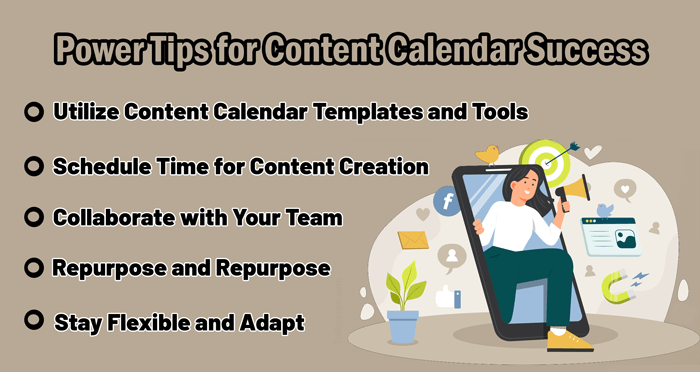
Suggested Articles to Read More
- What Is Citations In SEO?
- Sustainable Link Building Strategies
- Advanced Long-Tail Keyword Targeting Strategies
- Google Discover Traffic Secrets & Hacks
- visual search trends and strategies for SEO
- content freshness and SEO examples
- voice search optimization techniques
- local SEO for small cafes
Conclusion: Content Calendar Chaos Conquered!
By implementing these strategies and utilizing the power of a content calendar, you can transform your content creation process from disorganized madness to a well-oiled machine. Remember, the key lies in planning, organization, and leveraging the right tools. Take control of your content destiny by conquering content calendar chaos and watch your content marketing efforts soar! Embrace the power of a strategic content calendar, and witness the transformation – from feeling overwhelmed and lost to becoming a content creation champion!
For more information about Search Engine Optimization, we suggest that you click on Free SEO Tutorial [+]. Also, if you have any questions about SEO, you can ask them in our SEO Support Center [+] in the form of a topic and wait for the answer from our experts.
Please share your comments and give us 5 stars. We can use your valuable suggestions and criticisms.
FAQs: Conquering Content Calendar Chaos
What’s the biggest advantage of using a content calendar?
A content calendar helps you overcome the most common challenges of content creation, like missed deadlines, inconsistent quality, and a lack of direction. It provides a structured and organized approach to planning, creating, and publishing your content, keeping you on track for success.
I have a brand new website. How often can I realistically post new content?
While there’s no one-size-fits-all answer, new websites typically benefit from a more frequent posting schedule to establish themselves and build an audience. Aim for at least 2-3 new content pieces per week in the initial stages. You can adjust the frequency later based on your website’s traffic and audience engagement.
Are there any free content calendar templates available?
Absolutely! There are many free content calendar templates readily available online. Simple spreadsheet programs like Google Sheets offer free templates you can customize for your needs.
How can I analyze the performance of my content?
Several free and paid tools can help you analyze your content’s performance. Google Analytics is a free tool that provides valuable insights on website traffic, audience demographics, and how your content performs in terms of engagement and conversions. Most social media platforms also offer built-in analytics dashboards to track content performance on their specific channels.
